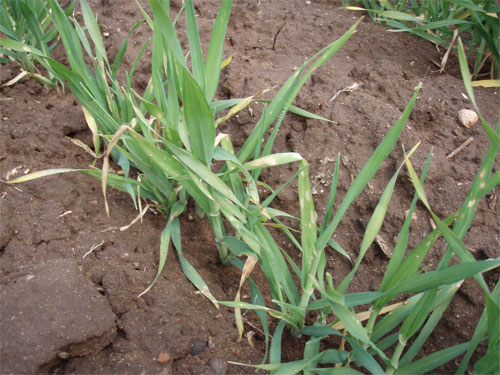Australia
November 28, 2014
 Zinc deficiency in a young barley crop. Photo: Nigel Wilhelm, SARDI
Zinc deficiency in a young barley crop. Photo: Nigel Wilhelm, SARDI
Grain growers planning to retain seed from this year’s harvest for sowing next season are encouraged to be selective about the seed they save.
Larger seeds with high nutrient content are recommended for retention as they promote stronger growth in young seedlings.
Seeds from crops grown on more fertile soils should also be targeted, according to South Australian Research and Development Institute (SARDI) research leader Dr Nigel Wilhelm, whose research is supported by the Grains Research and Development Corporation (GRDC).
Dr Wilhelm, who did his PhD in trace elements and has been involved in numerous GRDC-funded nutrient projects, said seedlings deficient of trace elements were generally weaker and less vigorous. Manganese (Mn) and zinc (Zn), especially, play a role in the defence mechanisms of young seedlings against diseases such as rhizoctonia.
“Avoiding deficiencies early can help plants fight off the ravages of rhizoctonia and I think that’s a real benefit of getting seed that’s rich in Mn and Zn,” he said. “Deficiencies of either will also restrict root growth, which is something growers need to avoid.”
Dr Wilhelm said being more stringent at seed grading by adjusting sieves to screen for smaller seeds was also worthwhile. “Another option growers could consider is seed dressing,” he said. “The seed you’re going to use next year can be coated with dressing that supplies the trace elements required to give it a good start.”
Dr Wilhelm said growers whose soils were lacking fertility could boost the seed nutrient content artificially. “One option is to buy in seed from different soil types, but the problem with that is the potential to bring in weed seeds and it is expensive,” he said.
“Another solution is to boost the nutrient levels of seeds in home-grown crops with a very late application of trace elements to the crop, in particular manganese (Mn) and zinc (Zn).” Dr Wilhelm said with harvest underway for many growers, it was now too late for them to take up the option of a late application of trace elements.
More information on retaining seed for next year’s cropping programs is contained in a southern Paddock Practices column, available for viewing via www.grdc.com.au/MR-RetainingRightSeed. A GRDC Retaining Seed Fact Sheet is available for download at www.grdc.com.au/GRDC_FS_Retainingseed.